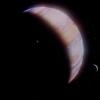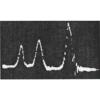Ultracold atom experiment confirms universal series of states
After 40 years of work, experimentalists finally find conclusive evidence for the existence of a universal series of states, first predicted by Efimov.
Newton was a very smart man. As he worked on solving the problem of predicting planetary orbits, he saw that his solution wasn't going to work. To predict and understand planetary orbits requires calculus, and calculus is hard. Not hard as in "I am going to fail math," but hard as in "No matter what trick I play here, these equations have no solution that I can just write down." Newton saw this problem pretty early on, and found that given just two bodies (e.g., the Earth and the Moon), he could solve the equations and come up with orbital predictionsadd in a third (or more), and solutions just vanished.
As it turns out, this is a pretty general issue in physics. Given two bodies that are interacting, the calculus is generally solvable; once that third body turns up, solutions vanish quicker than a kid's gratitude to Santa. Thus was born the three-body problem and many, many horrible physics jokes.
Fast forward to 1970 and a theoretical physicist, called Efimov, who was interested in how nucleons stuck together to form a nucleus. He discovered that under certain very restricted conditions, three nucleons could come together to form a resonant bound statebasically, the three nucleons would stick together. Furthermore, a large number of bound states existed in a series that showed a trait called self-similarity. Further investigation showed that if the particles were neutral and spinless, the number of resonant states would shoot up to infinity. Forty years later, experimentalists have finally caught up with Efimov.
As Efimov noted in his original paper, the conditions that produce these resonant states were both very general (as long as there was a resonant interaction, an Efimov state could be induced) and very restrictivethe range of the interaction force compared to some critical length scale had to fall within a certain range of values before the series of Efimov states would emerge. Some quick calculations showed that the states might exist in lighter nuclei, but the "series" for these nuclei would involve, at most, one state. As a result, the search for Efimov states was limited to looking for nuclear states that, according to the shell model of nuclear physics, shouldn't actually exist.
Bron: Ars Technica
Lees verder: http://arstechnica.com/science/news/2010/0...tm_campaign=rss
Wetenschappelijk artikel: DOI: 10.1126/science.1182840
Laatste berichten
-
15:53
positie

-
14:16
do-re-mi-fa-so vliegtuigen 7

-
14:16
Kunnen quantum Zonnecellen 190% quantum efficiënt zijn 3

-
13:57
De Euro Nederlandse 100 qubit computer komt eraan

-
11:32
[scheikunde] Kan chloorgas de geleiding van elektriciteit belemmeren? 6

-
11:31
geen minkowski-ruimte toch? Doe ik dit nou fout? 14

-
10:42
projectiel 8

-
10:37
Verschil tussen deze 2 vragen 5

-
09:48
Schroefdraad berekening 4

-
09:25
[scheikunde] berekeningen labo vitamine c bepaling 1

-
19:29
[wiskunde] rode en witte ballen verdelen 8

-
17:23
Rotatie van het heelal 41

-
22 apr
Weerfrustratie 5

-
22 apr
Muntje opgooien 14

-
21 apr
Reactiviteit silyl enol ethers 1

-
21 apr
Criterium voor vochtretentie

-
21 apr
speciale rel. theorie 5

-
21 apr
Vogels in de stad zijn goede klussers

-
21 apr
Ervaringen met "herontdekkingen" 15

-
20 apr
Herleiden afmetingen vanaf een foto 19

Nieuwsberichten
-
04 mar
Een nieuw soort magnetisme: altermagnetisme

-
31 okt
AI kan via stem diabetes vaststellen 11

-
21 okt
Einstein krijgt wéér gelijk 45

-
07 feb
witter dan wit 20

-
19 jun
irrigatie en de aardas
